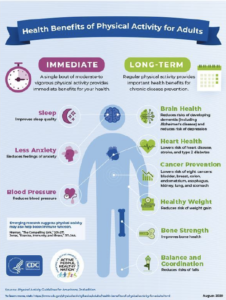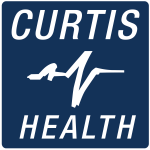Physical activity saves lives and dollars. Inactivity contributes to 1 in 10 premature deaths.
About 110,000 deaths could be prevented if adults increased moderate-to-vigorous physical activity by even 10 minutes per day.
The total costs of excessive sedentary behavior in Canada were $2.2 billion and $1.8 billion in 2021, representing 1.6% and 1.3% of the overall burden of illness costs, respectively. The two most expensive chronic diseases attributable to excessive sedentary behavior were cardiovascular disease and type 2 diabetes. A 10% decrease in excessive sedentary behavior (from 87.7% to 77.7%) would save an estimated $219 million per year in medical costs.
Immediate Benefits of Physical Activity for Adults
A single bout of moderate-to vigorous physical activity provides immediate benefits for your health.
● Improves sleep quality
● Reduces feelings of anxiety
● Reduces blood pressure
Long-Term Benefits of Physical Activity for Adults
Regular physical activity provides important health benefits for chronic disease prevention.

– Reduces risks of developing dementia (including Alzheimer’s disease) and reduces risk of depression
● Heart Health
– Lowers risk of heart disease, stroke, and type 2 diabetes
● Cancer Prevention
– Lowers risk of eight cancers: bladder, breast, colon, endometrium, esophagus, kidney, lung, and stomach
● Healthy Weight
– Reduces risk of weight gain
● Bone Strength
– Improves bone health
● Balance and Coordination
– Reduces risks of falls
● Improved immune function
● – Helps ward off viral illness
Benefits For Children:
● Academic Performance
– Improves attention and memory
● Brain Health
– Reduces risk of depression
● Muscular Fitness
– Builds strong muscles and endurance
● Heart and Lung Health
– Improves blood pressure and aerobic fitness
● Cardiometabolic Health
– Helps maintain normal blood sugar levels
● Long-term Health
– Reduces risk of several chronic diseases, including type 2 diabetes and obesity
● Bone Strength
– Strengthens bones
● Healthy Weight
– Helps regulate body weight and reduce body fat.
How do you successfully incorporate exercise into your routine?
1. Identify a physical activity you actually like. There are many ways to work out other than boring yourself senseless on a treadmill. Find a physical activity you can look forward to doing, like tennis, swimming, dancing, softball, or even vigorously playing the drums. You are far more likely to stick with an activity if you genuinely enjoy doing it.
2. Invest in improving your performance. Instead of settling for “getting some exercise,” focus on mastering an activity instead. Mastery goals, which psychologists define as goals that center on achieving new levels of competence, have consistently been shown to predict persistence across a wide range of domains. So hire a coach, enroll in a class, and buy yourself the right clothing and equipment. The additional financial investment will increase your level of commitment, while the steady gains in performance will help sustain your interest over the long term.
3. Become part of a group, not a collective. One recommendation aspiring gym-goers often receive is to find an exercise regimen that involves other people. It’s good advice. Socializing makes exercise more fun, which improves the chances that you’ll keep doing it. It’s also a lot harder to back out on a friend or a trainer than to persuade yourself that just one night off couldn’t hurt.
******************
Citations
1. Centers for Disease Control and Prevention. (2022, July 14). Why should people be active? Centers for Disease Control
and Prevention. Retrieved April 28, 2023, from
https://www.cdc.gov/physicalactivity/activepeoplehealthynation/why-should-people-be-active.html#:~:text=Inactivity%20co
ntributes%20to%201%20in,even%2010%20minutes%20per%20day.


